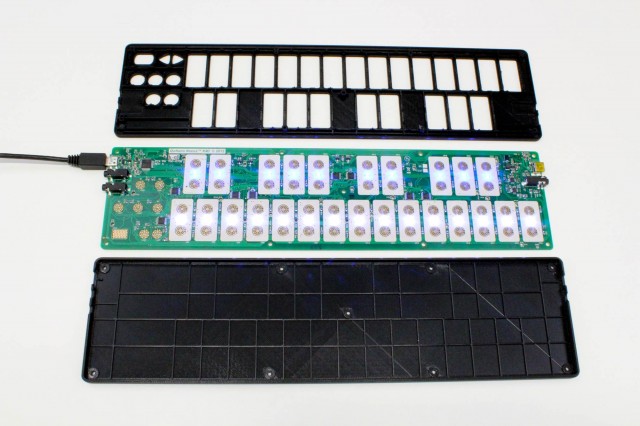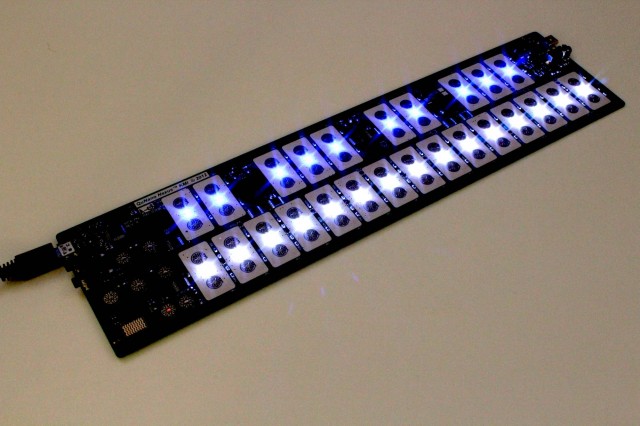
A fully-functioning QuNexus prototype. It may look like the pads on the QuNeo, but Keith McMillen tells us new sensor tech should be more friendly to keyboard technique. And the fact that this is real hardware is important – Kickstarter has recently revised its rules. A look at the new hardware – and actually delivering on Kickstarter – as CDM talks to Keith McMillen.
Can a compact controller not only shrink the conventional music keyboard, but transform it, too? The layout on the just-announced QuNexus is something familiar to keyboard players. But the QuNexus assumes some new ways of playing, with keys that sense pressure and an instrument that you can tilt. Following in the footsteps (fingertaps?) of Keith McMillen’s QuNeo, the QuNexus is built around a custom-engineered set of pressure-detecting, touch-sensitive pads. But whereas previous hardware used USB for MIDI and high-resolution OSC (OpenSoundControl), the QuNexus adds Control Voltage for modular and vintage lovers, too.
The QuNexus returns to Kickstarter for crowd-funding production, a technique that raised quite a lot of money last time – and a desire to ship more quickly has even sent KMI staff to China to check suppliers first-hand – but more on that in a moment. First, a look at the hardware:
25 LED-lit “Smart Sensor” Keys with Pressure, Tilt, and Velocity
Polyphonic Aftertouch
7 Octave range
Pitch Bend Pad
2 CV/Gate Inputs
3 CV/Gate Outputs (16-bit)
Blue and White LED Illumination
14 oz, 3.5″ x 10″ x .5 ”
USB-powered, no drivers needed (Mac, PC, Android and iOS)
At first glance, this all looks just like another QuNeo with a different layout. But the QuNexus, says its makers, features new sensor technology specific to this method of playing, and the addition of Control Voltage could reshape the target audience. I also know that everyone who plays with their QuNeo and SoftStep products is impressed by just how thin, light, and compact this gear is, which could set it apart from some alternatives. The challenge for QuNexus could be competition both from KMI’s own QuNeo (and its more-capacious control layout), and ever-affordable conventional MIDI keyboards. While old-fashioned keyboards are bigger and lack the cooler features here, keyboardists are of course quite comfortable playing them. But there’s some potential here for people wanting something ultra-compact and with some different sensors; Keith McMillen himself talks about what that might be, and you can get a basic feel in the video.
The test of that market is now, as KMI again uses crowd funding to launch the project.
Kickstarter, Take Two
Keith McMillen today is both announcing the QuNexus and an accompanying Kickstarter campaign. That will likely rekindle a discussion of crowd funding as a model, for KMI and beyond. For all the exploding popularity of Kickstarter, the fundamental model – backers providing money before a product ships – has caused some friction. Specifically, KMI faced backer backlash when production of the QuNeo was heavily delayed by a supplier problem.
DJ Tech Tools published a must-read article on the history of QuNeo’s bumpy crowd-funded ride, in an in-depth story by veteran music tech writer Kylee Swenson:
Creating DJ Hardware With Kickstarter: The Right Move For KMI’s QuNeo?
The tale of that one supplier breakdown is one that hits close to home for me, as CDM collaborates with engineer James Grahame on the MeeBlip. [Full disclosure: CDM is now readying a Kickstarter campaign, unrelated to hardware, and … yes, we’re also a manufacturer.] I liked this quote by Keith in Kylee’s article:
It brings into question the ethics of manufacturing in China. “It’s a land of great expansion,” McMillen says:
“It’s like the Wild West, and you’re gonna run into problems. Some of the stuff that goes into the QuNeo can only be built there because they have the most sophisticated machinery. If I tried to build this stuff in North America, it’s not even possible. So as a nation, we got ourselves into this, and there are pluses and minuses.”
MeeBlip is produced by a Canadian business and a German business, but this relationship to China still holds. And even simple parts like knob caps are often available in flexible quantities, greater varieties, and significantly lower costs in China. Dealing with China means dealing with suppliers over great distances and across language barriers, and quality and reliability can be wildly variable.
In China or locally, suppliers can break down, ship parts with flaws, and ship late: this is simply part of the reality of manufacturing. (I’ve gotten a crash course in that phenomenon with my first two years of involvement in custom manufacturing on MeeBlip. Ask me over a drink some time, or stick around – at some point, I hope we’ll get to talk more about our experience.)
The challenge with Kickstarter is that your relationship to the project isn’t as a buyer, but an investor. When you buy a product, any supply chain wrinkles have been absorbed in advance. Even most preorders will not take your money until they ship. When you’re a Kickstarter backer, you’re investing in a product, which means sharing some of the risk. QuNeo isn’t alone by any means. Kickstarter recently updated its terms of service, including changes like requiring imagery of actual prototypes and not mock-ups, and requiring projects to detail challenges they might face. From their blog:
The payoff is, by getting backers from the market for a product, it’s possible to take risks on products that otherwise might be impossible. QuNeo was and is something different, with original engineering from a small maker. You need some sort of capital to do that, regardless; in this case, the investor is you. And investment involves risk.
CDM talked to Keith McMillen himself about the project, to understand his design goals and what he’s learned as he takes Kickstarter for a second go-around.
Interview
CDM: Is there a pricing model in place for this?
We are thinking $200 list and ~ $150 street. This is similar model as we did for QuNeo and everyone was happy with it.
The QuNeo Kickstarter campaign was a success from a funding standpoint. But it also came under some criticism for shipping delays – which, in turn, have been an issue with Kickstarter campaigns more generally. How are you responding to new Kickstarter guidelines in terms of deliverables?
Here are the answers we gave to Kickstarter on this exact topic – many address your questions:
This is our second Kickstarter project and here are some of the things we have learned from our past experience, and feel that we have improved for this campaign.
1. We have identified a strong set of vendors for our components. We’ve sent KMI personnel to our Chinese factories in order to supervise and oversee production. These relationships are functioning smoothly and provide us with high quality products on a regular basis.
2. We have structured our reward levels to better track foreign and domestic backers.
3. We’ve established a system for improved communication with backers. This includes more regular updates and better monitoring of messages and comments.
4. This project is far enough along in design and realization where we feel confident we can deliver in a timely manner, even with potential bumps in the road.
Are you able to assure people that you’ll be able to ship product more quickly in this case than with QuNeo?
Yes. The delay for QuNeo came from one component supplier who would not admit they had made faulty product. Since we were talking 350,000 parts they were very slow to respond, and it took us a while to find a new supplier that could source in quantity. We now buy all of our components from approved, known-good vendors, and all of the components in the QuNexus have good second sources. I am confident we will hit our schedule.
You spoke about some of the challenges of hardware vendors in China. But given that unpredictability, does that simply weaken the incentive for doing preorders? That is, if you’re buying an already-manufactured product, then quality and availability concerns remain in the hands of the manufacturer, not the buyer, right? Or, is there an incentive here to fund a product that wouldn’t exist otherwise?
I think there are several incentives to back new projects. We made a lot of decisions on QuNeo’s behavior based on user input and suggestions. Kickstarter supporters are a pretty savvy group, and caused us to include functionality and compatibility we probably would not have been able to consider without their help. Backers get to have input at a really ideal time. The basics are in place so it is not a pie in the sky discussion, but the firmware and support software is not set. People can imagine what they want to do with the new instrument and can communicate that to a receptive design group.
And we are a small company doing original and, I feel, important work in the nascent field of musician – computer interface. Ideally we would be supported by a benevolent monarchy or an eccentric millionaire, but we are doing this out of our personal need for better and more responsive instruments. Kickstarter is a fantastic way for people to express their support and enable new musical modes.
Apart from CV input and output, what’s the advantage of this versus the QuNeo – that is, might some people simply map pitch to the QuNeo and be happier with that, given more controls?
First of all, the sensor pads are different from QuNeo. The QuNexus keys have grip while the QuNeo keys slide. This grip transfers the player’s gesture to the sensors in a more piano like manner. Even though the keys are not conventional, all of the players have said QuNexus plays faster, and with more certainty, than any of their other controllers. It is a different instrument for different purposes.
Secondly, I have made a lot of violins, but never felt that one of them could substitute for a guitar. If you have keyboard skills already or want to learn to play, the QuNexus is satisfying and inviting.
Speaking of QuNeo – what’s the state of this project? At this point, there’s no backlog of hardware? Is demand still high, and do you anticipate it will remain so with this new launch?
Demand is strong and growing. We have shipped several thousand QuNeos after sending out units to our Kickstarter backers. Reviews are coming in and have been positive to rave level in response. From one of the articles: “There’s a new level of control available through this device which we feel is the start of a new era in digital music control.”
Most people have never seen or played a QuNeo. When they do, the take-up is very fast, and people get their lights flipped on when they can use a single gesture and get a complex response. After a few minutes they wouldn’t want it any other way—it feels sensible.
I expect the new Kickstarter campaign to appeal to a wider range of players and shine a light on the possibilities of all of our new generation of musical instruments.
Thanks, Keith. We’ll be watching.
QuNexus Smart Sensor Keyboard Controller

